时间:2024-12-16 点击量:
“室内空气环境质量控制”天津市重点实验室,建造环境课题组(BERL)与南洋理工大学合作,在中科院一区TOP期刊《Separation and Purification Technology》(影响因子IF:8.1)上发表了最新研究成果:Nanoscale architecture: Enhancing the performance of nanofiber air filters with bead-on-string structures.
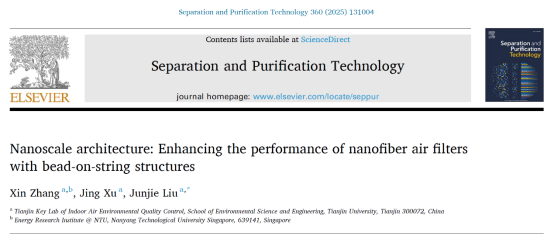
一、题目
纳米尺度结构:利用串珠结构增强纳米纤维空气过滤器的性能
Nanoscale architecture: Enhancing the performance of nanofiber air filters with bead-on-string structures
二、作者
Xin Zhang a, b(张鑫),Jing Xu a(徐敬),Junjie Liu a(刘俊杰,通讯作者)
a 天津大学环境学院,“室内空气环境质量控制”天津市重点实验室
b 南洋理工大学,能源研究所(ERI@N)
三、研究亮点
· 总结了文献中已经报道的空气过滤纳米纤维材料的串珠参数。
· 建立了参数可调的串珠结构纳米纤维材料模型。
· 尺寸略大于纤维直径的串珠结构性能最佳。
· 在本研究范围内,30%的BVF可产生最高的品质因数。
四、研究背景
人类大约90%的时间都待在室内,因此室内空气质量(IAQ)对健康和舒适度都至关重要。在室内污染物中,气溶胶尤其有害,可能导致严重的呼吸系统疾病、心血管疾病和其他并发症,如SARS-CoV-2等病毒也很容易通过气溶胶传播。因此,纤维空气过滤器被广泛用于减轻气溶胶带来的危害。这些过滤器采用纤维结构来捕集颗粒物,同时允许空气流过。纤维对颗粒物的捕集受扩散、拦截、惯性、重力和静电效应等机制控制,这些机制因颗粒物的大小和纤维直径而异。然而,随着颗粒物在过滤器上积聚,其透气性会降低,从而导致更高的压降,增加的压降导致空气输送能耗显著增大。
为了减轻纤维空气过滤器的高能耗,有人提出用静电纺丝纳米纤维材料替代玻璃纤维和熔喷无纺布等传统过滤介质。纳米纤维由于其表面的滑移效应而表现出较低的气流阻力,这是其纳米级纤维直径而导致的结果。虽然纳米纤维过滤介质保持较低的压降和较高的颗粒物捕集效率,但颗粒物主要积聚在迎风面上,这会缩短过滤器的使用寿命。压降的快速增加会导致风机能耗增加,并需要频繁更换过滤器,从而带来巨大的环境负担。设计一种蓬松的纤维结构以在纤维中容纳更多的颗粒物是一种延长纳米纤维介质使用寿命的有效方法。
静电纺丝方法允许通过调整纺丝参数来设计纤维结构。这些参数包括溶液特性,如电导率、粘度、表面张力和挥发性,以及喷嘴直径和喷射速率、电场强度、纤维收集距离、纺丝环境相对湿度(RH)和温度。通过选择合适的溶液类型和纺丝参数,可以实现各种结构,如串珠、蛛网、树枝状和多种纤维直径。串珠结构因其能够增强纳米纤维介质的过滤性能而得到广泛报道。这种结构通常通过简单调整溶液浓度或粘度、环境RH和电场强度来实现。尽管已有大量研究集中于纳米纤维结构的设计,但这些结构对过滤性能影响的理论分析仍未得到深入探索。在各种设计中,串珠结构是报道最广泛且最容易实现的,通常通过简单调整溶液粘度或环境湿度即可。了解纤维结构与过滤性能之间的理论关系对于增强纳米纤维设计至关重要。
为了解决这一问题,我们首先总结了当前已经实现的串珠参数设计,基于材料科学中开发的串珠结构,我们对单个串珠纤维进行了模拟,以评估其性能。模拟评估了不同空气速度下的压降、不同尺寸颗粒物的捕集效率以及综合了压降和捕集效率的品质因子。通过这些模拟选择性能最佳的串珠形状,然后将其应用于虚拟串珠模型,以确定最佳串珠体积分数(BVF)设计。在进行不同BVF串珠结构模拟之前,我们通过真实纳米纤维介质的实验结果验证了虚拟纤维模型。
五、主要成果
1. 单个串珠参数分析
· 图 1(a)描绘了一种典型的串珠结构,其中珠子的特征为长度(dl)和高度(dh),纳米纤维的直径为df。我们将珠子长度与珠子高度之比定义为形状因子(Pf = dl / dh),该因子主要描述椭球形珠子形状,值越大表示形状越细长。尺寸因子(Sf = dh / df)(珠子高度与纤维直径之比)定量描述了珠子尺寸。
· 串珠形状因子主要集中在1~4之间,个别数值超过4,甚至达到8;串珠尺寸因子一般集中在2~15之间,少数超过15,但不超过50。

Figure 1. Summary of structural parameters from published literature. (a) Schematic diagram and scanning electron microscope (SEM) image of a typical bead-on-string structure [1]. (b) Bead length (dl) and height (dh) of fibers with different diameters (df). (c) The relationship between the shape factor (the ratio of bead length to height, Pf = dl / dh) and the size factor (the ratio of bead height to fiber diameter, Sf = dh / df) for fibers with different diameters.
图1. 已发表文献中的结构参数总结。(a)典型串珠结构示意图和扫描电子显微镜(SEM)图像 [1]。(b)不同直径(df)纤维下的珠子长度(dl)和珠子高度(dh)。(c)不同直径纤维下的形状因子(珠子长度与珠子高度的比率,Pf = dl / dh)和尺寸因子(珠子高度与纤维直径的比率,Sf = dh / df)之间的关系。
2. 串珠形状和尺寸设计
· 球形和椭球形珠子均有助于降低压降,椭球形珠子的效果略好一些。随着尺寸因子的增加,效率会降低,从而对过滤性能产生不利影响。质量因子会随着尺寸因子的轻微增加而提高,随着尺寸因子的进一步增加而下降,之后由于压降的显着降低而再次上升。此外,随着尺寸因子或形状因子的增加,最易穿透粒径(MPPS)趋于降低。
· 串珠形状因子对压降的影响很小,其对大于MPPS颗粒物的捕集效率的影响最为明显,尽管这种影响并不一致。最高的颗粒物捕集效率以及最高的质量因子发生在形状因子为1.5时,尽管质量因子在不同情况下的变化通常很小。
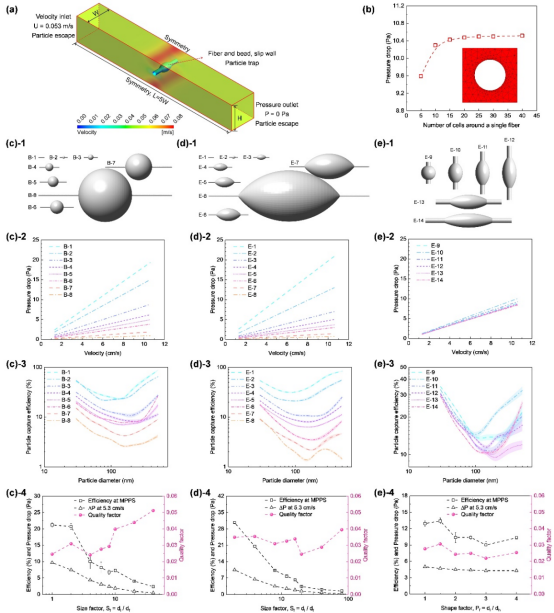
Figure 2. Bead shape design using single bead-on-string structure simulation. (a) An example of the simulation model with boundary conditions. (b) Mesh independence analysis of the single bead-on-string structure simulation. (c)-(e) Ball and ellipse structural bead shape design considering the size factor (Sf) and the shape factor (Pf). The performance parameters include pressure drop (ΔP), particle capture efficiency, and quality factor. The quality factor was calculated using ΔP at 5.3 cm/s and efficiency at the most penetrating particle size (MPPS).
图2. 使用单串珠结构模拟进行串珠形状设计。(a)包含边界条件的模拟模型示意图。(b)单串珠结构模拟的网格独立性分析。(c)-(e)考虑尺寸因子(Sf)和形状因子(Pf)的球形和椭球形结构串珠形状设计。性能参数包括压降(ΔP)、颗粒物捕集效率和品质因子。品质因子是使用5.3 cm/s时的ΔP和最易穿透粒径(MPPS)时的效率计算得出的。
3. 串珠结构纳米纤维介质性能模拟
· 模拟的压降与实验值非常接近,均方根误差(RMSE)为3.24 Pa。颗粒物捕集效率的模拟结果也与实验值高度一致,RMSE为6.61%。
· 在本研究范围内,BVF为30%的模型表现出最高的品质因数。虽然将BVF从40%增加到50%会导致更高的品质因数,但这种改进是以牺牲颗粒物捕集效率为代价的。
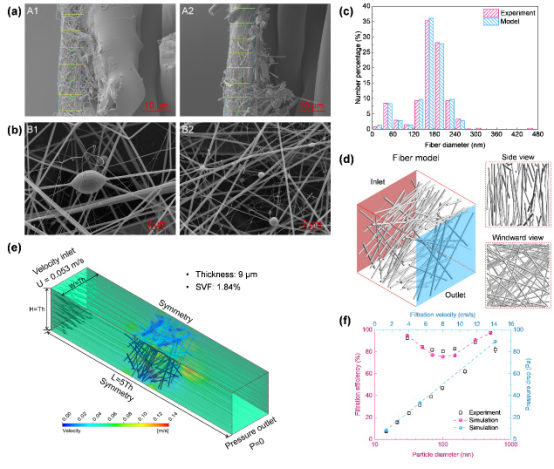
Figure 3. Validation of the performance simulation method for nanofiber media. (a), (b) Cross-sectional and surface SEM images of the PAN nanofiber media used in this study. (c) Fiber diameter distribution derived from experimental results compared to that used in the simulation model. The number percentage refers to the fraction of fibers counted from SEM images (experiment) and fiber models (model). (d) Example of the fiber model utilized in the simulation. (e) Flow field simulation results for the fiber model, including boundary condition settings. (f) Comparison of pressure drop and particle capture efficiency between experimental and simulation results.
图3. 纳米纤维介质性能模拟方法的验证。(a)、(b)本研究中使用的聚丙烯腈(PAN)纳米纤维介质的横截面和表面SEM图像。(c)从实验结果得出的纤维直径分布与模拟模型中使用的纤维直径分布的比较。数量百分比是指从SEM图像(实验)和纤维模型(模型)中计算出的纤维分数。(d)模拟中使用的纤维模型示例。(e)纤维模型的流场模拟结果,包括边界条件设置。(f)实验结果和模拟结果之间的压降和颗粒物捕集效率比较。
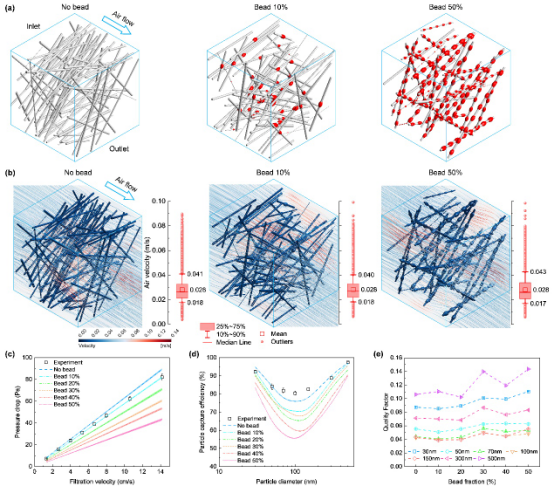
Figure 4. Bead-on-string structure design of nanofiber media. (a) Examples of bead-on-string structures utilized in this study. (b) Simulated airstreams and air velocity distribution for the model examples. (c)-(e) Simulation results of various bead-on-string structures, showcasing pressure drop, particle capture efficiency, and quality factor.
图4. 纳米纤维介质的串珠结构设计。(a)本研究中使用的串珠结构示例。(b)模拟气流和空气速度分布示例。(c)-(e)各种串珠结构的模拟结果,展示了压降、颗粒物捕集效率和品质因子。
4. 串珠结构对介质性能的影响分析
· 其他纤维模型参数(例如,纤维直径分布和SVF)保持不变时,串珠结构导致空气速度的增加,进而造成压降减少。
· 将珠状结构纳入纤维模型可增强过滤性能,尤其是在MPPS周围。
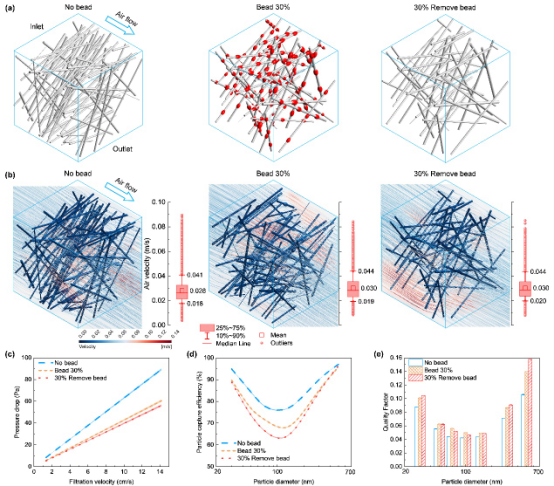
Figure 5. The impact of bead structures on filtration performance. (a) Comparison of nanofiber models: one without bead structures (“No bead”), one with a 30% bead structure (“Bead 30%”), and the “Bead 30%” model with its beads removed (“30% remove bead”). (b) Simulated airstreams and air velocity distributions for the models. (c)-(e) Simulation results for various fiber models, focusing on pressure drop, particle capture efficiency, and quality factor.
图5. 串珠结构对过滤性能的影响。(a)纳米纤维模型的比较:一种没有串珠结构,一种有30%串珠结构,以及去除珠子的“Bead 30%”模型。(b)模型的模拟气流和空气速度分布。(c)-(e)各种纤维模型的模拟结果,重点关注压降、颗粒物捕集效率和质量因子。
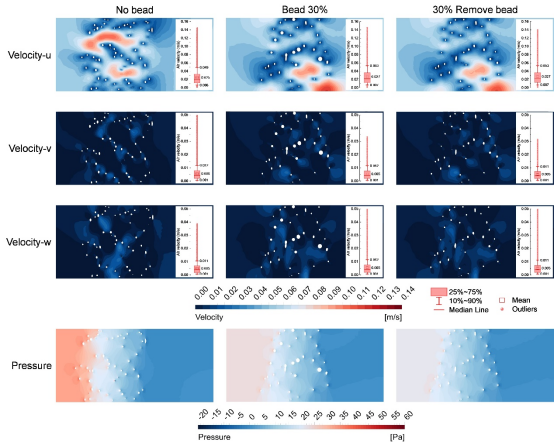
Figure 6. The schematic analysis on the impact of bead structures on the air velocity and pressure fields around the fiber model. The three components of air velocity—u (flow direction), v (width direction), and w (height direction)—were examined individually. A statistical analysis of the absolute air velocity values surrounding the fiber model was conducted, and cross-sectional slices through the middle of the width were displayed. The fiber models analyzed include: a model without bead structures (“No bead”), a model with a 30% bead structure (“Bead 30%”), and the “Bead 30%” model with its beads removed (“30% remove bead”).
图6. 串珠结构对纤维模型周围空气速度场和压力场的影响的示意图分析。分别检查了空气速度的三个分量——u(流动方向)、v(宽度方向)和 w(高度方向)。对纤维模型周围的绝对空气速度值进行了统计分析,并显示了宽度方向中部的横截面切片。分析的纤维模型包括:没有珠子结构的模型、具有30%珠子结构的模型和去除珠子的“Bead 30%”模型。
参考文献:
[1] Z. Wang, C. Zhao, Z. Pan, Porous bead-on-string poly(lactic acid) fibrous membranes for air filtration, J Colloid Interface Sci, 441 (2015) 121-129.
致谢:
本研究得到了中国国家重点研发计划(2022YFC3702803和2023YFC3708400)和中国国家自然科学基金(51978452)的支持。
本文引用格式:Zhang, X., Xu, J. & Liu, J. Nanoscale architecture: Enhancing the performance of nanofiber air filters with bead-on-string structures. Separation and Purification Technology 360 (2025). https://doi.org/10.1016/j.seppur.2024.131004
阅读原文:https://doi.org/10.1016/j.seppur.2024.131004
稿件编辑:张鑫
审核人:刘俊杰
田媛
于欣宇
